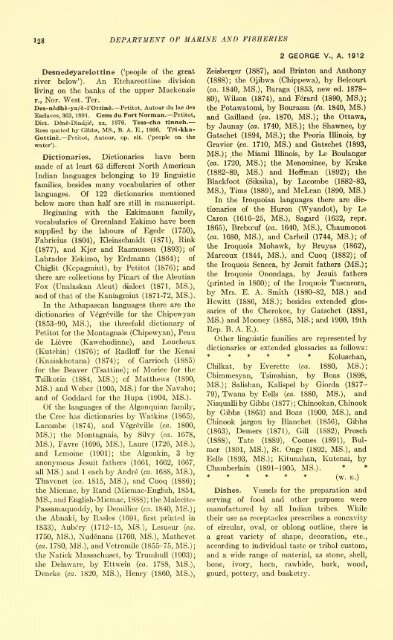Handbook of Indians of Canada - ElectricCanadian.com
Handbook of Indians of Canada - ElectricCanadian.com
Handbook of Indians of Canada - ElectricCanadian.com
Create successful ePaper yourself
Turn your PDF publications into a flip-book with our unique Google optimized e-Paper software.
128<br />
DEPARTMENT OF MARINE AND FISHERIES<br />
Desnedeyarelottine ('people <strong>of</strong> the great<br />
river below'). An Etehareottine division<br />
living on the banks <strong>of</strong> the upper Mackenzie<br />
r., Nor. West. Ter.<br />
Des-n6dhe-ya/56-rOttin6.—Petitot, Autour du lac des<br />
Esclaves, 363, 1891. Gens du Fort Norman.—Petitot,<br />
Diet. Ddn^-Dindji^, xx, 1876. Tess-cho tlnneh.<br />
Ross quoted by Gibbs, MS., B. A. E., 1866. TPi-kka-<br />
Gottine.—Petitot, Autour, op. cit. ('people on the<br />
water').<br />
Dictionaries. Dictionaries have been<br />
made <strong>of</strong> at least 63 different North American<br />
Indian languages belonging to 19 linguistic<br />
families, besides many vocabularies <strong>of</strong> other<br />
languages. Of 122 dictionaries mentioned<br />
below more than half are stiU in manuscript.<br />
Beginning with the Eskimauan family,<br />
vocabularies <strong>of</strong> Greenland Eskimo have been<br />
supplied by the labours <strong>of</strong> Egede (1750),<br />
Fabricius (1804), Kleinschmidt (1871), Rink<br />
(1877), and Kjer and Rasmussen (1893); <strong>of</strong><br />
Labrador Eskimo, by Erdmann (1864); <strong>of</strong><br />
Chiglit (Kcpagmiut), by Petitot (1876); and<br />
there are collections by Pinart <strong>of</strong> the Aleutian<br />
Fox (Unalaskan Aleut) dialect (1871, MS.),<br />
and <strong>of</strong> that <strong>of</strong> the Kaniagmiut (1871-72, MS.).<br />
In the Athapascan languages there are the<br />
dictionaries <strong>of</strong> Vegreville for the Chipewyan<br />
(1853-90, MS.), the threefold dictionary <strong>of</strong><br />
Petitot for the Montagnais (Chipewyan), Peau<br />
de Lievre (Kawchodinne), and Loucheux<br />
(Kutchin) (1876); <strong>of</strong> Radl<strong>of</strong>f for the Kenai<br />
(Knaiakhotana) (1874); <strong>of</strong> Garrioch (1885)<br />
for the Beaver (Tsattine); <strong>of</strong> Morice for the<br />
Tsilkotin (1884, MS.); <strong>of</strong> Matthews (1890,<br />
MS.) and Weber (1905, MS.) for the Navaho;<br />
and <strong>of</strong> Goddard for the Hupa (1904, MS.).<br />
Of the languages <strong>of</strong> the Algonquian family,<br />
the Cree has dictionaries by Watkins (1865),<br />
La<strong>com</strong>be (1874), and Vegreville {ca. 1800,<br />
MS.); the Montagnais, by Silvy {ca. 1678,<br />
MS.), Favre (1696, MS.), Laure (1726, MS.),<br />
and Lemoine (1901); the Algonkin, 3 by<br />
anonymous Jesuit fathers (1661, 1662, 1667,<br />
aU MS.) and 1 each by Andre {ca. 1688, MS.),<br />
Thavenet {ca. 1815, MS.), and Cuoq (1886);<br />
the Micmac, by Rand (Micmac-English, 1854,<br />
MS., and English-Micmac, 1888) ; the Malecite-<br />
Passamaquoddy, by Demillier (ca. 1840, MS.);<br />
the Abnaki, by Rasles (1691, first printed in<br />
1833), Aubery (1712-15, MS.), Lesueur {ca.<br />
1750, MS.), Nudenans (1760, MS.), Mathevet<br />
(ca. 1780, MS.), and Vetromile (1855-75, MS.);<br />
the Natick Massachuset, by Trumbull (1903);<br />
the Delaware, by Ettwein {ca. 1788, MS.),<br />
Dencke {ca. 1820, MS.), Hemy (1860, MS.),<br />
2 GEORGE v., A. 1912<br />
Zeisberger (1887), and Brinton and Anthony<br />
(1888); the Ojibwa (Chippewa), by Belcourt<br />
{ca. 1840, MS.), Baraga (1853, new ed. 1878-<br />
80), Wilson (1874), and F6rard (1890, MS.);<br />
the Potawatomi, by Bourassa (da. 1840, MS.)<br />
and Gailland {ca. 1870, MS.); the Ottawa,<br />
by Jaunay {ca. 1740, MS.); the Shawnee, by<br />
Gatschet (1894, MS.); the Peoria Illinois, by<br />
Gravier {ca. 1710, MS.) and Gatschet (1893,<br />
MS.); the Miami Illinois, by Le Boulanger<br />
{ca. 1720, MS.); the Menominee, by Krake<br />
(1882-89, MS.) and H<strong>of</strong>fman (1892); the<br />
Blackfoot (Siksika), by La<strong>com</strong>be (1882-83,<br />
MS.), Tims (1889), and McLean (1890, MS.)<br />
In the Iroquoian languages there are dictionaries<br />
<strong>of</strong> the Huron (Wyandot), by Le<br />
Caron (1616-25, MS.), Sagard (1632, repr.<br />
1865), Breboeuf {ca. 1640, MS.), Chaumonot<br />
{ca. 1680, MS.), and Carheil (1744, MS.); <strong>of</strong><br />
the Iroquois Mohawk, by Bruyas (1862),<br />
Marcoux (1844, MS.), and Cuoq (1882); <strong>of</strong><br />
the Iroquois Seneca, by Jesuit fathers (MS.);<br />
the Iroquois Onondaga, by Jesuit fathers<br />
(printed in 1860); <strong>of</strong> the Iroquois Tuscarora,<br />
by Mrs. E. A. Smith (1880-82, MS.) and<br />
Hewitt (1886, MS.); besides extended glos-<br />
saries <strong>of</strong> the Cherokee, by Gatschet (1881,<br />
MS.) and Mooney (1885, MS.; and 1900, 19th<br />
Rep. B. A. E.).<br />
Other lingiiistic families are represented by<br />
dictionaries or extended glossaries as follows:<br />
* * * * * * Koluschan,<br />
Chilkat, by Everette {ca. 1880, MS.);<br />
Chimmesyan, Tsimshian, by Boas (1898,<br />
MS.); Salishan, Kahspel by Giorda (1877-<br />
79), Twana by Eells (m. 1880, MS.), and<br />
NisqualUby Gibbs (1877); Chinookan, Chinook<br />
by Gibbs (1863) and Boas (1900, MS.), and<br />
Chinook jargon by Blanchet (1856), Gibbs<br />
(1863), Demers (1871), Gill (1882), Prosch<br />
(1888), Tate (1889), Coones (1891), Bulmer<br />
(1891, MS.), St. Onge (1892, MS.), and<br />
Eells (1893, MS.); Kitunahan, Kutenai, by<br />
* *<br />
Chamberlain (1891-1905, MS.). ****** (w. E.)<br />
Dishes. Vessels for the preparation and<br />
serving <strong>of</strong> food and other purposes were<br />
manufactured by all Indian tribes. While<br />
their use as receptacles prescribes a concavity<br />
<strong>of</strong> circular, oval, or oblong outline, there is<br />
a great variety <strong>of</strong> shape, decoration, etc.,<br />
according to individual taste or tribal custom,<br />
and a wide range <strong>of</strong> material, as stone, shell,<br />
bone, ivory, horn, rawhide, bark, wood,<br />
gourd, pottery, and basketry.

















